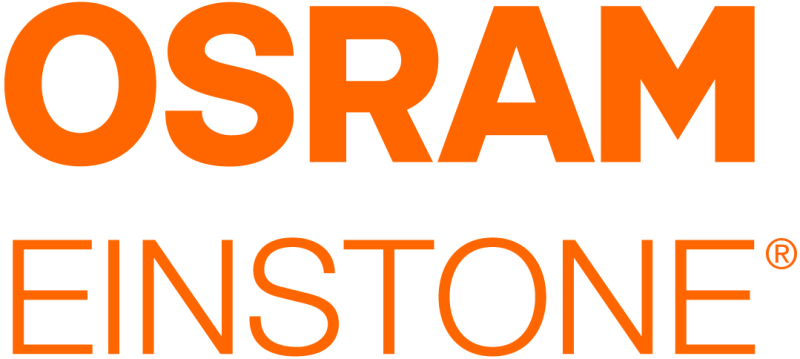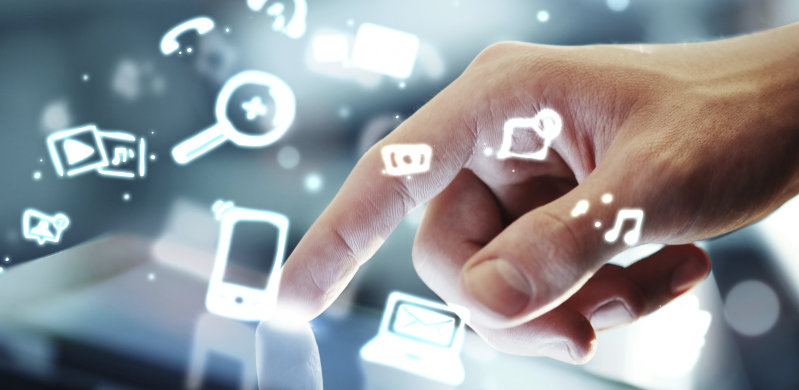OSRAM EINSTONE: Beacons combined with light
OSRAM EINSTONE brings the offline and online worlds together using intelligent transmitter units known as beacons, thereby enabling the implementation of location-based services. The lighting installation provides a stable, secure and low-maintenance beacon infrastructure for these services. With EINSTONE Smart Infrastructure and EINSTONE Smart Retail we can supply everything you require for your individual applications – from single components right through to complete solutions.

EINSTONE Smart Retail
The end-to-end solution for location-based services in retail: comprehensive customer understanding with an digital customer loyalty card for an exceptional customer experience.

EINSTONE Smart Infrastructure
The maintenance-free OSRAM EINSTONE beacon infrastructure, combined with the lighting installation, is the basis for various location-based services.
Technology
Definition: What is Beacon technology
Beacons act very much like lighthouses – they send out signals just to show they are there. Bluetooth Low Energy beacons are transmitters that continuously emit Bluetooth signals in default frequencies to relay information on the transmitter's identifier, location or status.
Beacons allow virtual, wireless interaction with consumers who are using mobile end devices such as smartphones, tablets and smartwatches. When a person with a mobile device and a matching app approaches a transmitter, the device picks up the beacon signal. The app can then trigger individual information or offers (location-based services) depending on the person’s location.
Frequently asked questions (FAQ)
The signals broadcast by the Bluetooth Low Energy beacons can be received by mobile end devices such as smartphones, tablets and smartwatches. The receiving device estimates the approximate distance to the transmitter by measuring the strength of the signal it has detected and, depending on the estimated distance, triggers an action stored in an app on the device. The shorter the transmission interval of a beacon, the lower the latency with which an action is triggered on the end device
If the beacon signal contains location information or ID data that allows the end device to determine the transmitter’s bearings, the position of the end device can be calculated by means of trilateration or fingerprinting.
The benefits lie in being able to address the customer personally and directly in the local brick-and-mortar store. In addition, combined with retail analytics, the technology offers retailers the possibility of specifically steering customer flows and providing customers with personalized information tailored to their respective location.
Beacons connect the online and offline worlds with each other. The ever-increasing growth in online sales is intensifying the pressure on in-store retailing. To benefit from the growing trend, retailers need to network their sales channels more strongly with each other – whether online, offline or mobile. A good way to do this is to use beacons. With their help, in-store retailers can address customers individually and provide them with relevant, personalized offers directly at the point of sale (POS). The range of the transmitters also makes it possible to address customers on the street and lure them into the store with interesting offers or product information.
Location-based services provide information tied to a specific geographical position. They are used to send selected, digital information tailored to a specific user at a specific location: For example, marketing campaigns such as advertising, discounts, coupons as well as navigation, locating objects and much more.
Users need a switched on mobile device with activated Bluetooth and location services. Many of the latest generation devices, such as wireless headsets or hands-free phones in cars, already have Bluetooth activated as a default setting. The user also needs a beacon-compatible app. When installing the app on the mobile device, the user must agree to receive push notifications or advertisements. Consent can be revoked at any time.
A mobile app is essential for use of the numerous functions and full potential offered by the Bluetooth low energy transmitters. OSRAM supports the integration of beacon functionality. In this way, an existing app can quickly be beacon-enabled using a Software Development Kit (SDK). Moreover, with its EINSTONE Smart Retail solution, OSRAM offers the possibility to set up a digital customer card as a smartphone app – in the customer's very own “Corporate Design” of course. The digital customer card not only opens up a new communication channel to the customer but can also attract further numerous mobile-oriented users as new customers.
The heart of the EINSTONE Smart Retail solution is the EINSTONE Suite. This retail analytics platform clearly structures and links the data from all sales channels (online, offline, mobile) in a web-based user interface. In-store retailers obtain a holistic understanding of their end customers with the EINSTONE Suite and can design appropriate purchase incentives.
The EINSTONE Suite offers solutions to diverse questions through the link with the beacon technology: What is the buying history of an individual customer or a customer group? Which campaigns were shown to the user? Which vouchers did the customer use? Which stores did the customer visit and how long did she or he spend in the store in question? Which products does the customer prefer – and much more.
BLE is an extension of Bluetooth wireless technology, optimized for low energy consumption through small data packets and limited transmission performance. As a result, BLE is particularly suitable for mobile and battery-powered terminals and also for IoT sensors. BLE is a standard today in almost all mobile devices with iOS or Android operating systems.
Near Field Communication, or NFC for short, has a very short range; up to 10 centimeters at the most. When NFC is being used, the transmitter and the receiver must be very close to each other for the data to be transmitted. Beacons offer a range of up to 100 meters and therefore, depending on local conditions, a greater diversity of options.
Beacons are configured with a beacon manager. Every beacon has its own individual settings, so that each one triggers different actions on the smartphone. Each beacon is assigned a unique identification number. This identifier is defined in a data package on the basis of predefined main information components. All these factors define the beacon so precisely that it can be unequivocally identified in later use. Example:
- UUID (Universally Unique Identifier) = 16-byte number for the assignment of beacons to a group, such as a corporate group. Each beacon in this group has the same UUID.
- Major = 2-byte number, for example to identify a particular company within the corporate group.
- Minor = 2-byte number to precisely identify individual beacons within the company.
If you would like to use the OSRAM configurator, please send an email to einstone@osram.com.
There are three major Beacon standards in use around the globe. The first standard is based on Apple's iOS operating system: iBeacon. iBeacon is a proprietary and closed standard with which various actions can be triggered. The second standard comes from Google: the Eddystone format is an open-source beacon standard. There is also the open source format AltBeacon.
OSRAM caters to all three standards with EINSTONE.
In this article, we will provide you with an overview of the technology and explain the data-privacy aspect of it to you. After all, OSRAM is committed to applications that comply with data privacy law and encourage conformity.
Technology: The word “beacon” is derived from the English term “signal fire.” Beacon technology is based on the principle of sender-receiver. For instance, small transmitters (beacons) are placed in a room or location with the sole purpose of sending a particular signal at defined intervals. These signals consist of combinations of numbers and letters.
Let's say that a department store customer has installed the store's app on his or her smartphone. It is an app that is configured to receive the beacon signal. When the phone enters the range of a beacon transmitter, the phone will receive the signal and transmit it to the app. The app will then perform an action defined by the store operator, such as providing information about a sale.
Data privacy aspect: The beacon itself is just a transmitter. It cannot receive or process data. The transmitter is also not assigned to a particular individual. It is simply placed in a location or room. Under these conditions, the use and operation of the transmitter are irrelevant in terms of data privacy law. Unlike the beacon, the installed app can receive and process information. If the app is connected to a user account (f.e. part of a customer loyalty program), personally identifiable information is created for the provider of the app.
As a result of this personally identifiable information, data may be processed as a rule only with the consent of the user. Because the user must actively install the app on his or her smartphone, the individual must receive a data privacy statement before the app is installed. This statement will inform the user about data processing and authorizations related to the app in a manner that complies with data privacy law.
Conclusion: The beacon itself has no data privacy consequences because it generally does not receive or process personal data. Any person who intends to offer and use the beacon function as part of an app has the ability to collect and use personal information (particularly by linking user accounts). As a result, this individual is obligated under data privacy law to inform users/customers about the planned data processing in a data privacy statement. (Last update: 05/2017)









